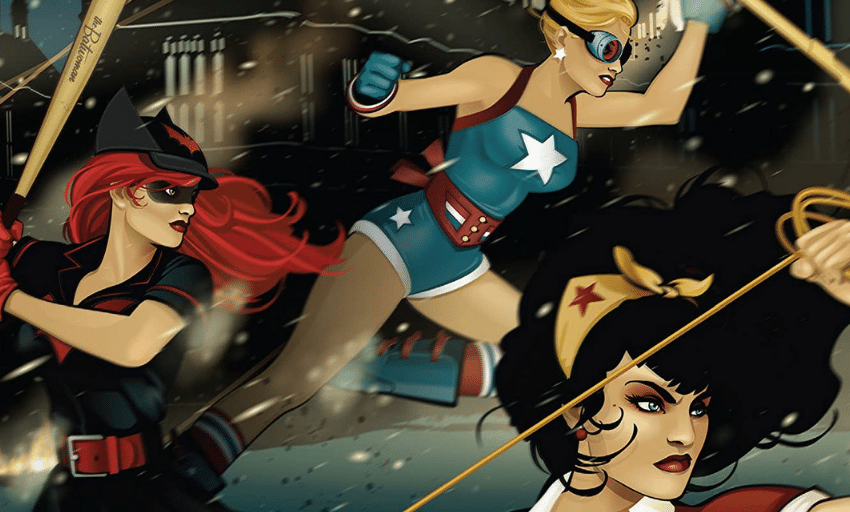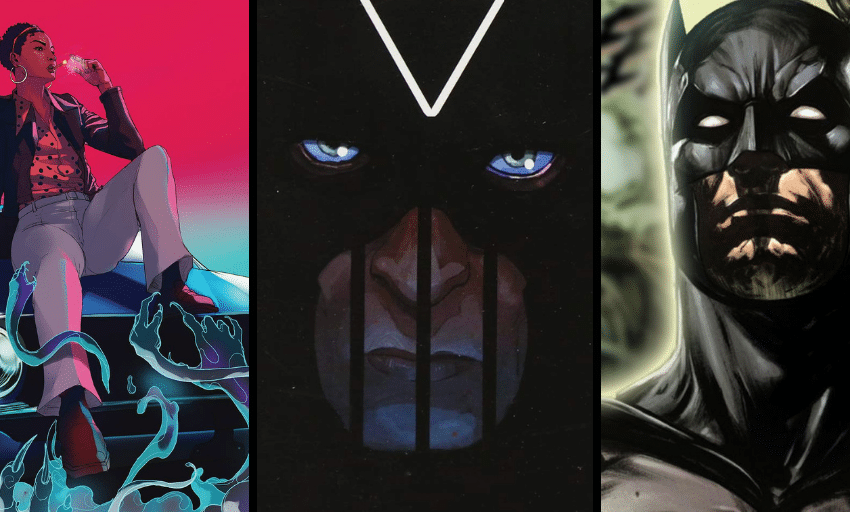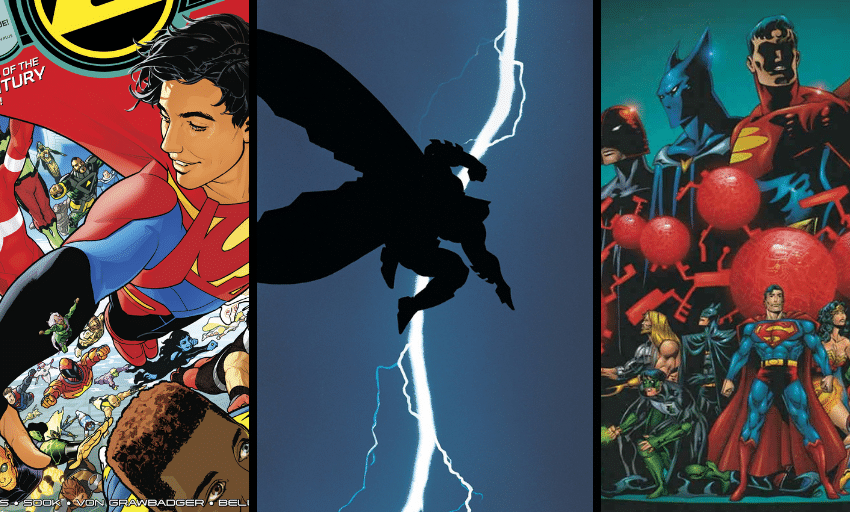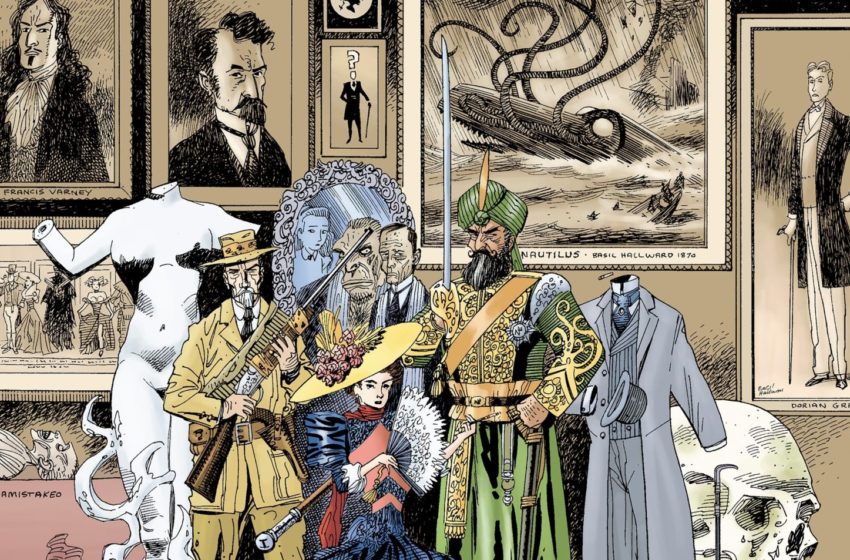Welcome back to Bonus Reading, the column where we take a character, creator or concept and tell you about four stories you should read or avoid. But today, it’s all about the recommendations, thanks to WMQ&A’s newest Patreon backer, the Loyalest Content Consumer, Asimov Fangirl! She asked for a column about the works of writer Marguerite Bennett, and so here we go.
Insexts

The first time I ever read any work by Bennett, it was one of the launch titles of then-new publisher AfterShock. Insexts, drawn by Ariela Kristantina, was a horror comic set in Victorian times that deals with sex, class, race and ladies who turn into insect/human hybrids to try to make a better place for themselves in the world. Can a concept sound any better than that right out of the gate?
Insexts is, at its core, a story of transformation and body horror, but is deeply feminist in how it approaches its themes. Lady Lalita Bertram is trapped in a loveless marriage to the unfaithful and abusive Harry Bertram. The only comfort in Lady Lalita’s life is her maid and love, Mariah. But the forbidden love between the two takes on a physical manifestation as they transform into insect/human hybrids of both beauty and horror. This is a horror story centering on queer, monstrous women as written by a queer woman, so it captures something that is rarely seen in this genre: They are monsters, but they are not evil. They are claiming the power they need to survive in a repressive and misogynistic society.
The series sees Lalita and Mariah try to live in a world that would hate them for their love and for their nature, while trying to raise their child and fight against supernatural forces. The series focuses not just on their queerness but on their race, as Lalita is Scottish and South Asian, so the pale and puritanical late 19th century London has another reason to distrust her. They fight a creature that feeds off all that underlying hatred in London in the first arc, and artists in Paris who use their models and monsters for their own nefarious ends in the second. The book is fascinating, layered and raw in the way that good horror as cultural criticism should be.
But a book like this, no matter how strong the writing, needs art that helps carry the load, and Kristantina certainly doesn’t shirk any of that weight. Her art is gorgeous and detailed. It moves seamlessly from intimate sex scenes to monsters tearing each other apart. Her butterfly women are as gorgeous as her mantis women are terrifying, and the facial work is excellent. The monsters that are not creatures, but are simply people who embrace the morals of the time, look even more evil under her pen. Add in the luscious colors of Bryan Valenza, and this team comes together to craft a tale of horror and love that I wish we could see more of.
Years of Future Past

Marvel’s most recent Secret Wars crossover was wild. Pretty much the entire Marvel line was canceled and replaced with an assortment of miniseries inspired by some of Marvel’s most famous, infamous or creator-favorite stories. The quality varied widely, and some of the concepts were more of a stretch than others. One of the better of these miniseries was indeed written by Bennett, and took off from one of the top five ranked X-Men stories of the Battle of the Atom podcast list: Years of Future Past.
Set years into the future of a “Days of Future Past”-esque world, Years of Future Past focuses on the last two mutants born before President Kelly’s regime sterilized all the mutants: Chrissy Pryde, daughter of Kate Pryde and Piotr Rasputin, and Cameron, the son of Wolverine. With the possibility of the overturning or amendment of the Mutant Control Act on the horizon, the few remaining X-Men plan to escape the concentration camp they are in after they discover a plan to assassinate Kelly and blame mutants. But there is more to this plot than meets the eye, and plans within plans are revealed that put Chrissy and Cameron on a collision course with each other.
As you might imagine for a story set in and around one of the most dystopian of Marvel’s timelines, this isn’t a lot of laughs. What it does, though, is in five issues establish Chrissy as a character you care about. Surrounded by some of the most famous X-characters (Shadowcat, Colossus, Magneto, Storm, Wolverine, Mystique, Nightcrawler), Chrissy stands out. Her narration is painful in its earnestness. Chrissy has been raised with more love and more education than most people in this world, and with the idea that she will be the one who helps lead mutants out of bondage, and so the messianic weight of the world is on her shoulders. Contrasted with Cameron (whose parentage is a little more obvious if you know your X-Men family trees), who has been raised out of the camps and living hand to mouth with Logan, we see the two extremes of the world, and how it has shaped the kids.
This world has been revisited a few times over the years, and this feels like one of the more natural continuations, rather than a forced one. Mike Norton, the artist on the book, is one of those artists who does consistent, if not flashy, work, and he really captures the dystopic, wrecked feeling of the world. My only complaint, and this is me being a very specific fanboy, is that for a writer who writes such great queer romances, and despite them both being in the book, Mystique and Destiny never share any page time, which feels like a missed opportunity.
Oh, and if that’s not enough, a giant Lockheed fights Sentinels that look like giant DoomBots. How can you pass that up?
DC Bombshells

One of the best parts of these Bonus Readings columns for me is the thrill of discovery. When I get a topic, I dig deep, not just into the tens of thousands of comics in my collection, but into works I haven’t read. And that’s how I just discovered DC Bombshells. I was aware of the book’s existence; it ran for quite a few years, but it came out at a time I had cut back my list a little, and so I had never read it, and I’m regretting that now because this series is delightful.
Set in a dieselpunk 1940s where America entered World War II before Pearl Harbor, the focus of the series, based on a line of ’40s pin-up style variant covers, are the heroes of this alternate world, all of whom are women. The series, which I admit to not having finished yet, is a lot of fun. After how serious both of the first two entries on this list are, Bombshells is a breath of fresh air. It’s not that there aren’t serious bits; this is set during wartime, after all. But while Bennett still touches on a lot of the social issues that she does in her other works, the world itself is easier to process: Who doesn’t look at a World War II story and know what side to root for? People I don’t want to be friends with, at least.
The series straddles all the genres of the time it is set: war stories, mysteries, action stories and horror, and they all blend in and out of each other. The colors are big and bright, and the art is sleek, stylish and cheekily sexy, with work from artists including Laura Braga, Ming Doyle, Garry Brown, Mirka Andolfo, Bilquis Evely and comics’ other Marguerite, Marguerite Sauvage.
So who are the heroes of the Bombshells universe? Well, the series starts out with Batwoman, who is not just a bat-themed vigilante but a player in an A League of Their Own-style women’s baseball league who defends Gotham with, well, a bat. This Kate Kane is in a happy relationship with Maggie Sawyer, and it’s nice to see Kate that way; I miss Kate and Maggie as a couple.
Wonder Woman is pretty much Wonder Woman as we know her; her origin was originally set in WWII, but the story updates Steve Trevor as a spy suffering from PTSD instead of a swaggering pilot. Wonder Woman is friends with Mera, who has fled Atlantis for reasons I haven’t fully discovered at the point I’m at in the series. Supergirl and Stargirl are sisters who are part of the Soviet Union’s propaganda machine before learning things aren’t what they seem. Catwoman is an Italian aristocrat who works as a spy. And Zatanna is a cabaret performer in Berlin who spies for the British and has a pet rabbit who is a transformed John Constantine.
They all work for or with Commander Amanda Waller, and I’m not even mentioning some of the other, more minor characters, like Big Barda and Dr. Light, and Harley and Ivy, who I just met in the last couple chapters I read. There’s a great mix of characters for those who know the DC Universe to pick up on as Easter eggs, but none of that knowledge is essential. Bombshells is a great series for those who want a different version of the DC Universe that is well thought out, exciting, and focused on characters that aren’t just the Big Seven JLA members.
Batwoman

Kate Kane, the newest (comic book) Batwoman, was introduced in 2006 and pretty quickly became one of the most prominent LGBTQ characters in comics. Due to all sorts of internal politics, it took DC five years to get Kate her own book. And then it took another six years for a queer woman to write a Batwoman ongoing (Marc Andreyko, one of DC’s more prominent male queer writers, did write the last issues of the first volume of Batwoman). Bennett started as co-writer of the title with James Tynion IV, who was writing Kate in his Detective Comics run at the time, and became the sole writer for the majority of the series’ far-too-short 18-issue run.
Spinning out of the events of Detective Comics, this volume of Batwoman starts with Kate on a globe-trotting adventure, looking into a drug called Monster Venom, a mixture of Bane’s Venom and Hugo Strange’s Monster Man serum. Accompanied by Julia Pennyworth, Alfred’s daughter, Kate ties the drug to an organization of arms dealers called the Many Arms of Death, run from the small island nation of Coryana. Kate has a connection with the Many Arms and Coryana, as the person in charge of both is Safiyah, an old paramour of Kate’s.
The first 16 issues (plus a Rebirth one-shot) form one arc, following Kate as she deals with Many Arms and its agents. It helps build a world outside of Gotham around Kate, which is good for her, even though the final issues reveal that Safiyah has taken Beth Kane, Kate’s previously seemingly reformed sister also known as the supervillain Alice, and corrupted her again. Alice is that character that Kate can’t escape, which makes sense, but after spending a year with new villains, or Kate encountering classic Bat rogues for the first time, the Alice reveal was a bit flat. Still, with art by Steve Epting and then Fernando Blanco, the series has a great feel that doesn’t try to duplicate the JH Williams III work that defined the earlier runs, but still is dynamic. After 16 big issues, the final two are a simpler, Gotham-set two-parter where Kate faces off with the Clock King while teaming up with her ex, Renee Montoya. The series ending hints at the two getting back together, which hasn’t really been followed up on, and that’s a shame.
If you’re watching the current season of the Batwoman TV series, you can see how much of this run has been reinterpreted for the show. It’s far from a literal adaptation, but it’s still interesting. The run has a feeling of being rushed at the end, and a lot of the emotional beats Bennett was building wrap up in a hurry, which is a shame, because she absolutely gets Kate Kane. I would love to see her get back to the canon Kate at some point, with Julia and Renee along for the ride, although Renee is kind of busy with being police commissioner in Gotham right now. Still, maybe she can slip on the ol’ Question mask and they could have one more adventure around the world. Kate Kane deserves a spotlight again, and Bennett deserves the chance to tell some more stories.
One final note at the end here: I didn’t want to delay this piece for two months and change, but Bennett looks like she’ll be having a great July, with the debut of M.O.M.: Mother of Madness co-written with Game of Thrones star Emelia Clarke, and a Batgirls story with art by previous WMQ&A guest Sweeney Boo in the Batman anthology Urban Legends.
Supporters of the WMQ&A podcast’s Patreon can request a Bonus Reading column on the creator, character or theme of their choice, in addition to other benefits. More info here!
Matt Lazorwitz read his first comic at the age of five. It was Who's Who in the DC Universe #2, featuring characters whose names begin with B, which explains so much about his Batman obsession. He writes about comics he loves, and co-hosts the creator interview podcast WMQ&A with Dan Grote.






